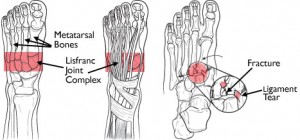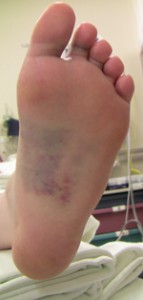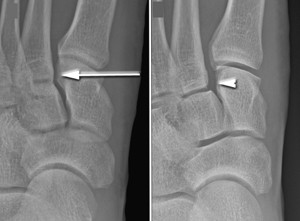
Our Physiotherapists have recently seen clients with foot injuries or ankle pain that come to see us because they have been slow to improve. This article is a timely reminder about this particular nasty injury that is often mistaken for a simple sprain, but if poorly managed can leave the injured person with permanent issues.
A Lisfranc injury is an injury to the midfoot. Often mistaken for a simple sprain, especially if the injury is a result of a straight forward twist and fall, injury to the Lisfranc joint complex is not a simple sprain and can not be “walked off”. Early diagnosis and correct treatment is incredibly important to prevent permanent long-term disability.
Other terminology to describe this injury include Lisfranc fracture, Lisfranc Dislocation, Tarsometatarsal injury or simply a midfoot injury. This type of injury is named after Jacques Lisfranc de St. Martin, the French surgeon who first described the injury in 1815.
A Lisfranc Injury is a severe injury that may take many months to heal and may require surgery in more severe cases.
 The midfoot is the middle region of the foot where a cluster of small bones forms the longitudinal arch of the foot. These bones are held in place by connective tissues (ligaments) that stretch both across and down the foot. A twisting fall can break or dislocate these bones out of place. This cluster of bones and ligaments is known as the Lisfranc Joint Complex. Lisfranc injuries include ligament strains, tears, fractures and dislocations of the ligaments and bones in the complex.
The midfoot is the middle region of the foot where a cluster of small bones forms the longitudinal arch of the foot. These bones are held in place by connective tissues (ligaments) that stretch both across and down the foot. A twisting fall can break or dislocate these bones out of place. This cluster of bones and ligaments is known as the Lisfranc Joint Complex. Lisfranc injuries include ligament strains, tears, fractures and dislocations of the ligaments and bones in the complex.
 This injury can be the result of a simple twist and fall. This is a low-energy injury and is commonly seen in football and soccer players. It is often seen when someone stumbles over the top of a foot flexed downwards.
This injury can be the result of a simple twist and fall. This is a low-energy injury and is commonly seen in football and soccer players. It is often seen when someone stumbles over the top of a foot flexed downwards.
More severe injuries occur from direct trauma, such as a fall from height or a forced hyperextension of the midfoot with a stable forefoot such as someone stepping on the front of the foot while running. These high energy injuries can be more likely to cause multiple fractures and dislocations of the joints.

If you have sustained a sprain to your midfoot, and have any of the above signs or symptoms your physiotherapist, sports physician or orthopoedic specialist is best equipped to assess and diagnose this condition. If your physiotherapist suspects that you have a Lisfranc injury, a confirmation of the diagnosis will be based on physical examination, and scans. The most appropriate scan is a comparison weight bearing x-ray and an MRI if there is any doubt.

This image shows a Non weight bearing X-ray on the left which would have missed the injury however the X-Ray on the right is weight bearing and has shown and obvious space between then first and second meta-tarsal which is indicative of a Lisfranc Injury.
Treatment for a Lisfranc injury depends on how severe the injury is. If there are no fractures or dislocations and the ligaments are not completely torn non-surgical treatment is an effective treatment for this type of injury. The treatment will consist of a non-weightbearing cast for 6 weeks. It is very important not to put any weight through the foot during this period. This will usually be followed by a walking boot for another 4-6 weeks before progressing to full-weight bearing.
If there are dislocations, fractures and abnormal position of the bones post injury surgery is indicated. The goal of the surgical treatment is to realign the joints and return the broken bones to a normal position. Treatment is usually internal fixation in which the bones are reduced and held in place with plates or screws.
If the injury is severe and has damage that cannot be repaired, fusion may be recommended as the initial surgical procedure. A fusion is essentially a “welding” process. The basic idea is to fuse together the damaged bones so that they heal into a single, solid piece.
Some athletes never return to their pre-injury levels of sport after these injuries. Despite excellent surgical reduction and fixation arthritis may occur from the damage to the cartilage. This may result in chronic pain and may require fusion in the future. Early correct diagnosis is vital to achieving the best possible outcome. This is one of those injuries that you should not “wait and see”.

Jude Holroyd is the Principal Physiotherapist at our Jordan Springs practice. You might be interested in other articles written by Jude including: